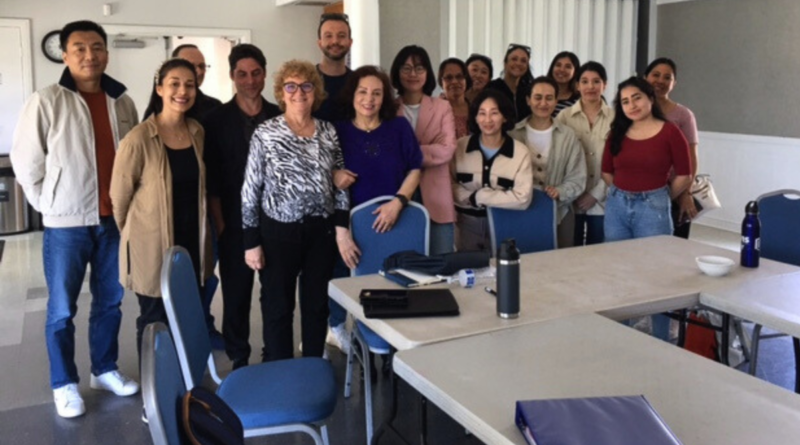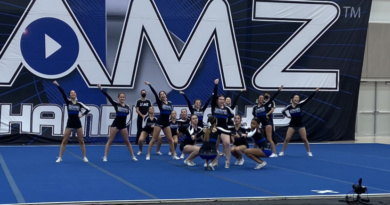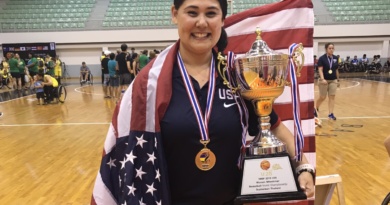English Language Programs Connect People of All Backgrounds
PHOTO: Participants in Victoria Whitworth’s conversation group line up after class, representing China, Colombia, Argentina, South Korea, Mexico, Italy, Peru, France, Spain, Turkmenistan and Iran. Photo courtesy of Victoria Whitworth.
By Maya Malinowski
BlueDevilHUB.com Staff-
Among other organizations in Yolo County, Davis has multiple English learning programs that help immigrants and refugees.
At the International House Davis
At the I-House, there are free weekly conversation classes held by different teachers on their individual days. They are conversation groups, so an intermediate level of English is necessary.
Çağrı Güzel, a PhD candidate in education at UC Davis, teaches on Wednesdays at 6pm and Mondays at 10am. From his work at UC Davis, Güzel brings a unique take on second language acquisition to the I-House.
“As an educator, I try to find spaces and opportunities to provide these stress-free, anxiety-free spaces that (learners) can practice speaking because that’s the only way to get better,” Güzel said.
To do this, he uses virtual reality (VR) on the Monday classes and in projects at UC Davis. As participants talk in a simulated environment, the application will analyze their speech and body language, then give individualized feedback.
However, it has its limits.
“Language inherently relies on social engagement; it requires human interaction,” Güzel said. “It cannot be confined to a virtual environment.”
To this end, Güzel implements improvisation exercises in his sessions. These exercises can be nonverbal, in which participants are forced to communicate with hand signals and body language; or they can be verbal, and require partners to build off of what the other says.
Güzel’s purpose behind these exercises is to build intercultural communication and make the students more used to uncomfortable situations. “That awkwardness can be humanized through this process of improvising, that’s basically what I’m trying to bring here,” Güzel said.
Victoria Whitworth also teaches at the I-House. She tries to keep sessions with conversation groups organic, and encourage the natural development of conversation.
“Honest to God, I do my lesson plan every week and I fret over it,” Whitworth said. “And half of the time, we don’t even get to the lesson plan because something happens, you know, that a conversation is sparked. They’re having fun.”
Her student, Mónica Rincón, has been with her in the US, over Zoom when she went back to her country, Colombia, during covid, and in Davis again now that she has returned. While learning English, the most difficult part for her was the listening aspect.
“Victoria and the other classes in I-House helped me a lot, because there are a lot of people from other countries,” Rincón said. “The accents are really different, so I had to learn how to understand the different accents and how they pronounce the words.”
At Davis High
At DHS, ELD (English Language Development) is the main program for students learning English as a second language. There are roughly 70 students at DHS who are English learners, although not all of them are taking ELD.
Kelly Wehrley has been the ELD teacher for a month and a half now, since substitute Scott Kuegler stopped teaching. This is Wehrley’s first time directly working in ELD, although he has tutored and taught for the past 18 years.
““I thought I had a better understanding (of ELD) than I did,” Wehrley said. “It’s been eye-opening.”
There are multiple components to the ELD classes; first, not all the students within the class are at the same level; second, they come from different cultural and educational backgrounds; and third, there is no state curriculum for ELD.
There is, however, an annual test administered by the California Department of Education, known as the ELPAC. The interface for the ELPAC is the same as CAASP testing, and tests students on listening, speaking, reading and writing.
Like the CAASP test, the ELPAC shows the state how well DHS is doing at teaching ELD. In addition, a student can also be reclassified from an English learner to a fluent speaker in the school system, if they score high enough.
So for Wehrley, he has to teach the students necessary skills for the ELPAC, but also things more applicable to their daily lives. And he has to cover these two priorities in the span of three years, tops.
“Sometimes it feels like a race against the clock,” Wehrley said. But still, he loves working with the students to find the learning method that works best for them.
Students come from multiple countries: Nicaragua, El Salvador, Honduras, Panama, Mexico, the Czech Republic, Ukraine, France, and Iran.
Ximena Navarro and Vladimir Moreno, both from the state of Sinaloa in Mexico, arrived separately in the US earlier this year, and started school at Davis High on April 8th.
*“I thought that I was going to get lost, because the school is very big,” Navarro said.
*Both Navarro and Moreno received minimal English classes back home. “They gave us classes, but they were a low level of English,” Navarro said.
As the teacher of the ELD classes, Wehrley speaks primarily in English, but there are staff members from DHS and tutors from UC Davis who help the students.
“They translate everything the teacher says for us,” Moreno said.
There aren’t translators in every class the ELD students have, though.
“The most complicated (class) is World Civ,” Moreno said. “The teacher explains, but I don’t understand her, I just take notes of what’s on the whiteboard.”
For students that have learned math solely in the CPM courses, terms like “SSS” (Side-Side-Side) in trigonometry are nothing new. But obviously, Navarro and Moreno didn’t learn in CPM; and so this is another thing that they have to adjust to.
“Certain things we take for granted are hard for them (the students),” Wehrley said. “They are learning a language and learning a culture (at the same time); there are so many layers, and no student is the same.”
This holds true for Navarro and Moreno, who each had their unique hobbies back home.
Moreno, for example, enjoys cooking.
“It came to my attention when I was eleven years old, because I was always at my mom’s side when she was in the kitchen,” Moreno said. “And, in a short amount of time, I started watching recipes on YouTube.”
And Navarro did weight lifting.
“I was in CrossFit, and the coach told me that I had really good mobility and I did the motions really well,” Navarro said. “And he told me I could do really well in lifting, for doing competitions.”
*Quotes from Navarro and Moreno have been translated from Spanish.




